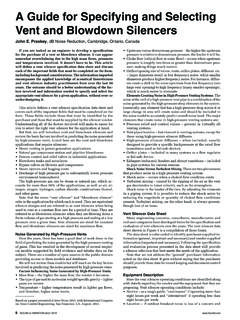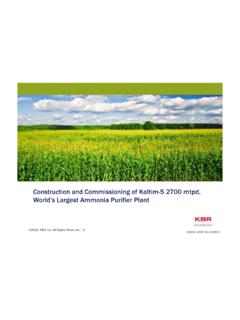Transcription of GLAUNACH
1 GLAUNACH THE SILENCER HANDBOOK DIMENSIONING A GUIDE TO PARAMETERS AFFECTING SILENCER SELECTION AND DESIGN GLAUNACH GMBH 2010 - ALL RIGHTS RESERVED -THE SILENCER HANDBOOK Part IV | page 2 of 14 GLAUNACH GMBH Edition 2010 1. ACOUSTIC DIMENSIONING PERMISSIBLE NOISE LEVELS (Lr) The key factor in designing a silencer installation is the (permissible) required noise level Lr, which has to be specified by the customer. Please note that the design noise level must conform to both user requirements and local legal limits and regulations, in particular such regarding acceptable (occupational) noise exposure. NOTE: If unsure about applicable requirements and standards, we recommend limiting the sound power level according to the US Occupational Noise Exposure standard OSHA Personnel Noise Protection Requirements (excerpted from OSHA and 2003/10/EC) When employees are subjected to sound levels exceeding those listed in the table below, feasible administrative or engineering controls shall be utilised.
2 If such controls fail to reduce sound levels to within permissible levels, personal protective equipment shall be provided and used to reduce sound levels to within the prescribed levels. PERMISSIBLE NOISE EXPOSURES Duration per Day [hrs.] Sound Pressure Levels [dB(A)], slow response 1) OSHA (US) 2003/10/EC (EU) 8 90 87 6 92 4 95 3 97 2 100 1 102 1 105 110 115 impulsive noise peaks 140 140 1) If the variations in noise level involve maxima at intervals of 1 second or less, it is to be considered continuous. If several valves open at the same time, the cumulative noise effect needs to be taken into account. THE SILENCER HANDBOOK Part IV | page 3 of 14 GLAUNACH GMBH Edition 2010 When the daily noise exposure is composed of two or more periods of noise exposure of different levels, their combined effect should be considered, rather than the individual effect of each.
3 If the sum of the following fractions C(1)/t(1) + C(2)/t(2) + .. + C(n)/t(n) C(n:) total time of exposure at a specified noise level t(n): total time of exposure permitted at that level. exceeds unity, then the mixed exposure should be considered to exceed the limit value. Exposure to impulsive or impact noise should not exceed 140 dB peak sound pressure level. For more details, please visit or NOISE LEVEL ADJUSTMENT BY DISTANCE ( Lr) Usually, the sound level is evaluated at a specific distance from the silencer shell. To calculate the noise levels adjusted by the distance, usually the hemispherical sound radiation model is used. Hemispherical Radiation Model (Half-Spherical Radiation) Noise emitted from a silencer installed on a level surface, for instance on a roof, without nearby vertical walls, etc. is in good approximation hemispherically radiated out into the environment.
4 The sound pressure levels decrease with increasing distance from the noise source, the silencer, according to the following formula: r: distance [m] Lr = 10 log(2 r ) [dB] THE SILENCER HANDBOOK Part IV | page 4 of 14 GLAUNACH GMBH Edition 2010 IMPORTANT REMARK The distance from the silencer axis to the silencer shell must also be considered in the noise calculation Example Calculation: The sound pressure level Lp5m measured 5 m from the silencer exit is 90 dB. a) Calculate the Sound Power Level LW 1) b) Calculate the expected sound pressure level Lp20m at a distance of 20 m from the outlet a) Lr = 10 log(2 ( +5) ) Lr = 22,8 dB LW = Lp5m + Lr = 90 + LW = dB b) Lp20m = LW 10 log(2 r ) = 112,8 10 log(2 ( +20) ) Lp20m = dB or, directly Lp20m = Lp5m 20 log (r2/r1) = 90 20 log(( +20)/( +5)) Lp20m = dB 1) assuming a point source 5m r THE SILENCER HANDBOOK Part IV | page 5 of 14 GLAUNACH GMBH Edition 2010 TRANSMISSION FACTORS ( LTF) Sound level adjustment by distance is only valid for i) unhindered transmission through air and ii) distances up to 25 m from the noise source.
5 If the sound level evaluation point is at a distance greater than 25 m, or if obstacles influence the sound propagation, the following factors should be considered: La air attenuation [dB] L direction correction [dB] Ls screening [dB] Lv attenuation by vegetation [dB] Lrx area factor [dB] Lb bottom attenuation [dB] also referred to as ground or terrain attenuation Several of these factors can only be accurately assessed on-site by a qualified acoustic engineer. The following concentrates on two factors that have almost always to be taken into account, air attenuation La and direction correction L : Air Attenuation ( La) A sound transmitted through air is attenuated in transmission by the air s viscosity and related factors. The sound absorption properties of air depend primarily on the frequency and the air s temperature and humidity.
6 The following table gives approximated attenuation coefficients for various acoustic frequencies for air with 10 C | 50 F and 70% relative humidity. f [Hz] 125 250 500 1k 2k 4k 8k La [dB/m] Direction Correction ( L ) silencers direct the sound energy along their main axis, in vertically installed silencers upwards. This effect can be included in the calculation by adding orientation-dependent correction factors. The following table lists the sound pressure level increments for different relative angles . THE SILENCER HANDBOOK Part IV | page 6 of 14 GLAUNACH GMBH Edition 2010 110 90 80 45 Silencer Roof 0 Orientation Angle [ ] 110 - 90 90 - 80 80 - 45 0 Correction Factor [dB] 1) 0 -1 -3 -20 : angle between silencer axis and evaluation point alignment Given the high noise levels at the silencer outlet and the preferential direction of noise in the direction of the gas plume, the silencer should preferably be directed upwards.
7 Under normal circumstances, the work area (and with it the noise measurement point) is thus below the horizontal axis of the silencer outlet. Weather hoods and similar devices reflect the sound downwards, even when equipped with a sound-absorbing surface. As this increases the sound level on the ground significantly, we recommend using hoods only if absolutely necessary. 1) All correction factors are given as attenuation factors, a negative factor indicates a higher noise level. THE SILENCER HANDBOOK Part IV | page 7 of 14 GLAUNACH GMBH Edition 2010 SOUND POWER LEVEL OF VALVES Valves are a primary source of noise in flow systems. A part of this acoustic energy is transmitted through the valve body, often necessitating an acoustic insulation of the valve itself; the greater part is dissipated through the flowing medium, requiring exhaust silencers .
8 The following two calculation models can be used for a rough estimation of the sound levels produced by a valve without a silencer: Valve Noise Estimation acc. to VDI 2713 LW0: sound power levels emitted by the valve [dB] M: mass flow capacity [t/h] NOTE: use M = 10 t/h for values < 10 t/h T0: Gas temperature at the valve [K] This formula calculates the overall sound power, the acoustic energy generated by the valve. This is an absolute value, which is not affected by environment or distance. Valve Noise Estimation acc. to ANSI/API RP 521 Lp30m: Sound Pressure Level at 30 m (100 ft) from stack tip [dB] L: internal sound power level [dB] M: mass flow capacity [kg/s] C: speed of sound in the gas at the valve [m/s] This formula calculates the sound pressure levels for an assumed monitoring point 30 m (100 ft) from the valve orifice.
9 This value, while directly related to the actual noise impression and the values measured with a sound meter, can in practice be affected by the surroundings. LW0 = 17 log(M) + 50 log(T0) 15 [dB] Lp30m = L + 10 log( M C ) [dB] COMMENT These calculations regard only the octave bands from 500 to 8,000 Hz; the resulting A-weighted levels are close to the unweighted dB(Lin) levels, and somewhat higher than the corresponding measured dB(A) values Both approximations yield values on the safe side. THE SILENCER HANDBOOK Part IV | page 8 of 14 GLAUNACH GMBH Edition 2010 Example Calculation: Calculate the sound power level of a safety valve venting water steam: mass flow capacity: 100 t/h upstream temperature: 500 C upstream pressure: 50 bar downstream pressure: 8 bar acc. to VDI 2713 M = 100 t/h T0 = 500 C + C = LW0 = 17 log(100) + 50 log( ) 15 163 dB acc.
10 To ANSI/API RP 521 The internal sound power level L is determined using an L/PR diagram contained in the ANSI/API RP 521 standard. This diagram s input parameter is the upstream/downstream pressure ratio PR, in the present example: PR = 50/8 6 For PR = 6, the L/PR diagram yields a internal sound power level L = 60 dB With the remaining input parameters M = 100 t/h = kg/s C = 664 m/s (value taken from Properties of Water and Steam ) the ANSI/API valve noise approximation yields a sound pressure level of Lp30m = 60 + 10 log( 664 ) = 128 dB Adjusting for the 30 m distance according to Section Lr = 10 log(2 30 ) = 38 dB LW0 = Lp30m + Lr = 128 + 38 166 dB yields the estimated sound power level LW0, which is required as input for installation design and dimensioning. THE SILENCER HANDBOOK Part IV | page 9 of 14 GLAUNACH GMBH Edition 2010 DETERMINATION OF SILENCER DYNAMIC INSERTION LOSS (DIL) To determine the necessary dynamic insertion loss (DIL) of any silencer, it is necessary to calculate the permissible sound power level LW at the silencer outlet.









